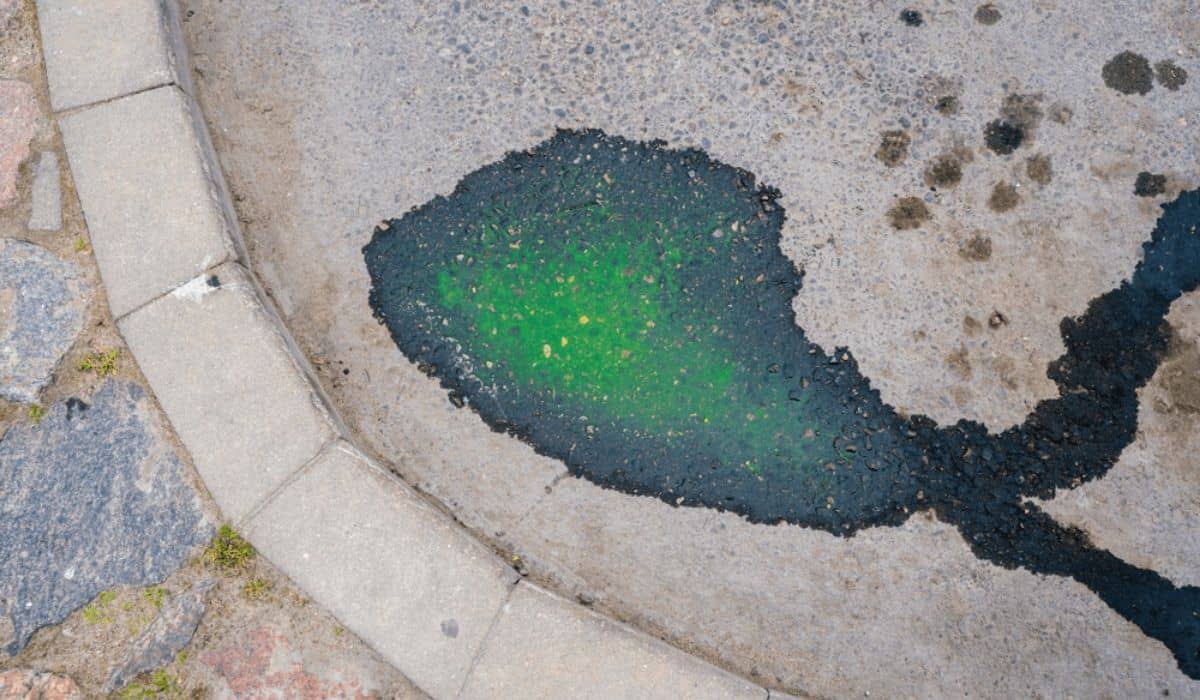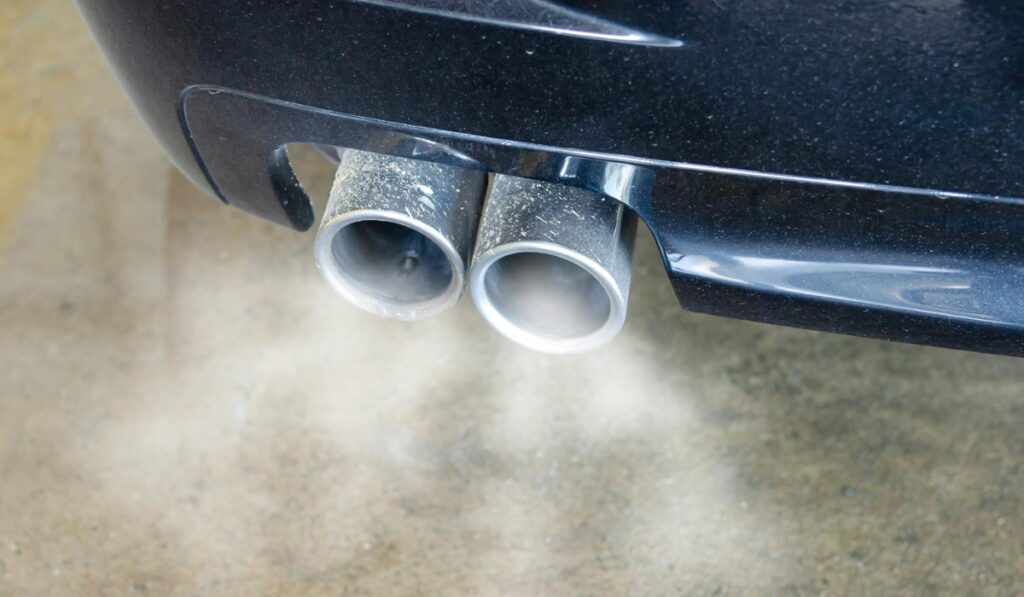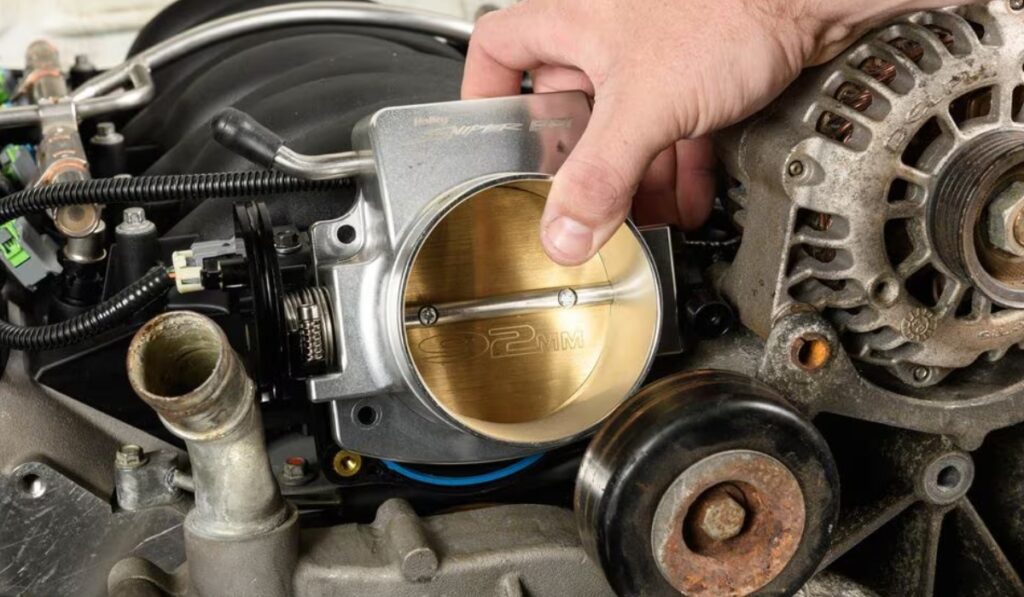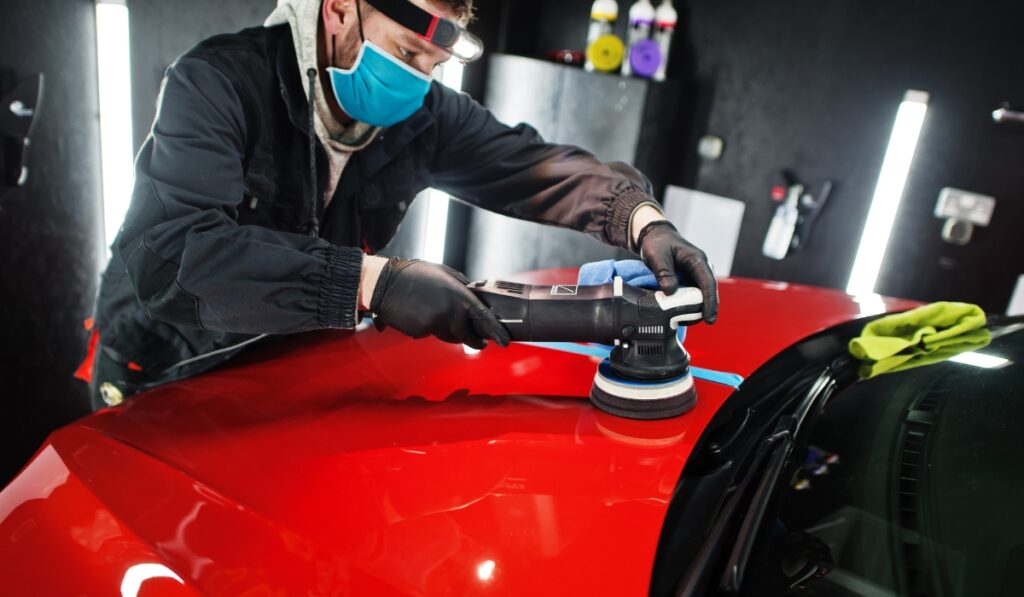As a car owner conscientious about the well-being of your cherished vehicle, the sudden emergence of green liquid oozing from beneath your car can be perplexing and, understandably, a cause for genuine concern.
This green fluid leaking from car is a clear indication of an issue within your car’s cooling system, a vital component for its optimal functioning.
| Aspect | Summary |
|---|---|
| Issue Identification | Coolant leaks from your car suggest problems in the cooling system components. |
| Importance of Coolant | Coolant regulates engine temperature, preventing overheating and corrosion. |
| Common Causes | Damaged hoses, radiator issues, and water pump malfunctions are frequent culprits. |
| Prevention Tips | Regular checks, proper coolant use, and professional maintenance prevent leaks. |
| Action Steps | Assess severity, top up coolant, avoid driving when overheating, and consult a mechanic. |
Causes of Green Liquid Leaks
Delving into the intricacies of this enigmatic situation, we uncover a multitude of potential culprits behind the green liquid leaks. Understanding these causes is paramount, serving as the first step in resolving this automotive mystery.
1. Coolant Leakage
Coolant, often synonymous with antifreeze, holds the key to regulating your engine’s temperature. Leaks within the cooling system, a complex network of components, can stem from various sources.
· Damaged Hoses:
Over time, hoses endure wear and tear, developing tiny cracks that allow coolant to seep through, presenting a silent but significant leakage challenge.
· Faulty Radiator:
The radiator, a crucial player in the cooling system orchestra, may succumb to damage or corrosion, transforming it into an unexpected source of coolant seepage.
· Leaking Water Pump:
Responsible for orchestrating the circulation of coolant, a malfunctioning water pump can turn into a stealthy accomplice in the fluid leakage saga.
2. Radiator Cap Issues
The seemingly inconspicuous radiator cap plays a pivotal role in maintaining the right pressure within the cooling system. A damaged or improperly secured cap can disrupt this delicate balance, paving the way for coolant leakage.
3. Heater Core Problems
The heater core, with its intricate network of tubes facilitating warmth in your car’s cabin, might harbor problems beneath its seemingly innocuous surface. Any damage to these tubes can unleash a cascade of green fluid, complicating the vehicular scenario.
4. Cracked Engine Block
In the realm of rare occurrences, a cracked engine block emerges as a potential troublemaker. Extreme temperature fluctuations or inadequate maintenance can birth cracks within the engine block, unleashing a green torrent of trouble.
Understanding Coolant
Coolant, often referred to as antifreeze, isn’t merely a green liquid; it’s the lifeblood of your engine’s temperature regulation system.
Understanding its composition, importance, and variations is instrumental in unraveling the complexities of green liquid leaks.
Importance of Coolant
1. Heat Transfer:
Acting as a heat absorber, coolant captures the thermal energy generated during the engine’s combustion process, facilitating its dissipation in the radiator.
2. Freeze Protection:
Formulated with additives to lower its freezing point, coolant safeguards against solidification in cold weather, preventing potential engine damage.
3. Corrosion Prevention:
The additives within coolant act as sentinels against corrosion, preserving engine components and the entire cooling system.
Composition and Types of Coolants
Coolants, typically a blend of glycol, water, and additives, come in two primary types: Inorganic Acid Technology (IAT) and Organic Acid Technology (OAT).
The green hue of coolant might vary, and deciphering its exact shade becomes an art of identification, crucial for distinguishing it from other automotive fluids.
Potential Cooling System Problems Explained
Spotting green fluid leaking from your car initiates a diagnostic journey into potential cooling system problems. Understanding these issues provides the groundwork for effective resolution.
1. Radiator Damage
A damaged radiator, succumbing to corrosion or age, can become a prime suspect behind coolant leaks. Cracks, bulges, or leaks around the radiator’s seams reveal the hidden drama within.
2. Worn or Faulty Hoses
Coolant hoses, the conduits of fluid circulation, are susceptible to wear over time. Cracks, bulges, or soft spots signal the wear and tear that transforms these seemingly mundane hoses into potential leakage points.
3. Malfunctioning Water Pump
The water pump’s malfunctioning can disrupt the symphony of coolant circulation, leading to leaks or even engine overheating. Visual cues like leakage around the pump’s housing or a loose pulley can act as clues to the underlying issue.
4. Cracked Cylinder Head or Engine Block
In the rarest of scenarios, a cracked cylinder head or engine block takes center stage. Severe overheating, a consequence of a hot engine or faulty cooling components, can result in fluid leaks with potentially grave repercussions.
5. Faulty Radiator Cap
A seemingly insignificant component, the radiator cap, can wield considerable influence. A defective cap may contribute to coolant loss through evaporation or overflow, emphasizing the importance of inspecting this humble yet crucial part.
6. Leaking Heater Core
The heater core, designed to provide warmth to your car’s cabin, might harbor leaks that allow coolant to infiltrate the interior. A sweet smell within the car accompanied by a green fluid leak is a telltale sign of heater core complications.
Identifying the Source of the Leak
When faced with green fluid leakage, the next logical step involves sleuthing out the precise source of the leak. This investigative process demands meticulous attention and a systematic approach.
1. Prioritize Safety
Safety takes precedence. Before embarking on the inspection odyssey, ensure your car is parked on a level surface, switched off, and has cooled down sufficiently.
2. Locate the Fluid
Begin the quest by identifying the pooling or dripping of green fluid. Inspect the undercarriage and note specific areas where the fluid concentration is notable.
3. Observe Color and Consistency
While green fluid generally suggests a coolant leak, confirmation comes from scrutinizing its color and consistency. A careful examination validates whether it’s indeed coolant or an impostor fluid.
4. Check the Coolant Reservoir
Pop the hood and locate the coolant reservoir, a transparent container offering insights into your cooling system’s well-being. Low coolant levels or signs of leakage around the reservoir demand attention.
5. Inspect Hoses and Connections
Systematically scrutinize visible hoses for signs of wear, cracks, or loose connections. Focus on junctions with radiators, water pumps, or thermostat housing, as these are prime locations for potential leaks.
6. Examine the Radiator
A thorough examination of the radiator, the epicenter of coolant activity, involves inspecting for visible leaks, cracks, or punctures. The radiator’s health is critical to the overall well-being of the cooling system.
7. Consider a Pressure Test
When visual inspection falls short, a pressure test becomes the investigative tool of choice. Applying pressure simulates normal operating conditions, unveiling hidden leaks that defy easy visual detection.
Identifying the source of a green fluid leak, though challenging at times, is a crucial endeavor. This intricate process ensures that any subsequent actions taken are not merely symptomatic but address the root cause of the leak.
If uncertainties persist or the origin remains elusive, seeking the expertise of a professional mechanic becomes a prudent choice.
Taking Action: Navigating the Road to Resolution
The sight of green fluid beneath your car necessitates prompt action. Addressing the issue effectively is not only about containment but also about preventing further harm. Here’s a strategic roadmap for responding to a green liquid leak:
1. Assess the Severity
Begin by evaluating the magnitude of the leak. The volume of fluid lost and the frequency of the leakage guide your initial response. Minor and infrequent leaks might warrant temporary solutions until a comprehensive inspection is possible.
2. Top Up Coolant
If the coolant reservoir reveals a level below the minimum mark, a judicious approach involves replenishing it with a mixture of 50% coolant and 50% distilled water. Caution is paramount to avoid overfilling, which could lead to excessive pressure within the system.
3. Avoid Driving When Overheating
Indicators such as overheating, steam emanating from the engine bay, or unusual noises necessitate an immediate cease in driving. Pull over safely, turn off the engine, and allow the vehicle to cool down to prevent compounding the issue.
4. Arrange Towing
In instances of substantial coolant loss or persistent leakage, driving your car becomes an unwarranted risk. Opt for towing services or roadside assistance to transport your vehicle safely to a trusted mechanic. This precautionary step averts exacerbating the problem during transit.
5. Avoid DIY Repairs
While the allure of DIY repairs might be strong, especially for those with mechanical know-how, coolant leaks often stem from complex issues. A professional evaluation is crucial as it ensures a thorough diagnosis and appropriate intervention tailored to the specific problem.
6. Consult a Professional Mechanic
Reaching out to a qualified mechanic, well-versed in automotive cooling systems, is the zenith of your responsive actions. Their expertise enables an accurate diagnosis and a targeted plan for repairs.
Entrusting your vehicle to their skilled hands ensures a resolution aligned with the intricacies of your car’s cooling system.
Swift and informed action mitigates the risk of engine damage, steering your vehicle away from potential catastrophes. Neglecting a coolant leak, however inconspicuous it may seem, can lead to dire consequences, including engine failure and substantial repair costs.
Prevention and Maintenance Tips
Preventing green fluid leaks involves proactive measures and consistent maintenance. These tips serve as a proactive defense, safeguarding your cooling system from potential vulnerabilities:
1. Regularly Check Coolant Levels
Frequently inspect the coolant levels in the reservoir. A consistent check allows early detection of any substantial drops in levels, signaling a potential issue that merits professional inspection.
2. Inspect Hoses and Connections
Periodically examine the hoses and connections within the cooling system. Any signs of wear, cracks, or loose fittings demand prompt attention. Swift replacement of worn components ensures the integrity of the entire system.
3. Use the Correct Coolant
Adhere to the coolant type recommended by your car manufacturer. Different vehicles may require distinct formulations, emphasizing the need to consult your owner’s manual or seek professional advice for precision.
4. Regularly Flush and Replace Coolant
Coolant, over time, can become contaminated and lose its effectiveness. Regular flushing and replacement, according to your vehicle manufacturer’s intervals, maintain optimal performance and prevent corrosion within the cooling system.
5. Maintain Proper Pressure
Regularly check the cooling system pressure using a pressure gauge. Consistently low pressure can compromise efficiency and potentially lead to leaks. Mechanisms for maintaining optimal pressure should be promptly addressed.
6. Prevent Overheating
Closely monitor your engine’s temperature gauge while driving. Any signs of overheating should prompt immediate action—pull over safely and allow the engine to cool down before continuing.
7. Seek Professional Assistance
At the first inkling of a green fluid leak, or if you identify potential issues during routine checks, seeking professional assistance is paramount. Experienced mechanics can conduct accurate diagnoses and provide timely repairs or replacements.
FAQ
Why Is My Car Leaking Green Fluid?
Green fluid leaking from your car is usually coolant, or antifreeze. This liquid is essential for engine temperature regulation. Damaged hoses, radiators, or water pumps in the complex cooling system can cause coolant leaks.
Engine damage can result from wear and tear or corrosion, so coolant leaks must be addressed immediately.
Can I Drive With A Green Fluid Leak?
Driving with a coolant leak is not advised. Driving with a leak can cause engine damage, coolant loss, and engine failure. Green fluid leaks should be assessed, coolant topped up, and professionally repaired before driving again.
Where Does The Green Fluid Leak Come From?
Green fluid leaks require systematic investigation. After safety, find the pooling or dripping fluid. Check its colour and consistency for coolant.
Inspect the radiator, coolant reservoir, and hoses and connections. If the source remains unknown, a pressure test may reveal leaks. A professional mechanic must be consulted for accurate diagnosis and resolution if uncertainties persist.
Should I Fix Coolant Leaks Myself?
DIY repairs are tempting, but coolant leaks have complex causes. Repairing without understanding the cooling system can cause more problems.
Professional mechanics can accurately diagnose and apply vehicle-specific solutions. Professional help ensures coolant leaks are fixed properly.
How Can I Prevent Green Fluid Leaks?
Green fluid leaks can be prevented with proactive maintenance. Check coolant levels and hoses for wear, cracks and loose fittings regularly. Use the car manufacturer-recommended coolant and flush and replace it regularly.
Maintain cooling system pressure and prevent overheating by monitoring the engine’s temperature gauge. Professional assistance at the first sign of a green fluid leak or during routine checks prolongs your vehicle’s cooling system.
Conclusion
Green fluid leaks from your car are not mere nuisances; they are signals from your vehicle, prompting your attention to critical issues within the cooling system.
This comprehensive exploration has unveiled the intricacies surrounding these leaks, empowering you to respond effectively and decisively.
Understanding the causes, properties of coolant, potential problems within the cooling system, and adopting preventive measures positions you as a proactive guardian of your vehicle’s health.
Regular maintenance and swift responses to emerging issues are the keys to a reliable and enduring driving experience.





